My interest in golden ragwort (
Packera aurea) as a landscape plant developed as I was looking for plants that could be used as traditional lawn alternatives. This eastern U.S. native looks good for most of the year, is relatively low-growing and easy to maintain, and has an ecological function beyond the monoculture of grass.
This native ragwort, along with others, should not be confused with the non-native, invasive tansy ragwort (
Senecio jacobaea). Don’t let its common name cause you to pass it over.
Not in the eastern U.S.? Browse plants native to other regions of the U.S.
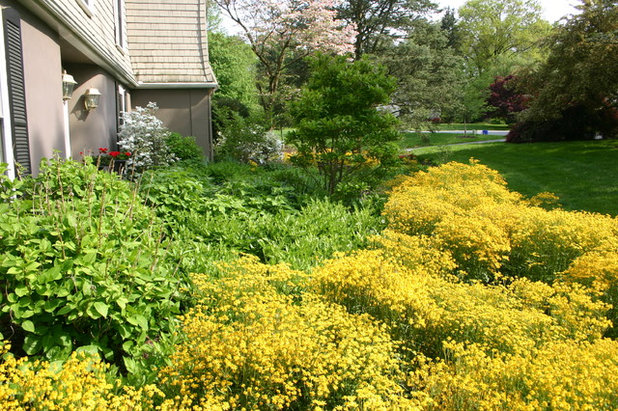 Botanical name: Packera aurea
Botanical name: Packera aurea (formerly
Senecio aureus)
Common names: Golden ragwort, golden groundsel
Origin: Native to the eastern U.S., from Maine to South Carolina and west to Texas and Minnesota; in Canada can be found from Newfoundland west to Manitoba
Where it will grow: Hardy to minus 40 degrees Fahrenheit, or minus 40 degrees Celsius (USDA zones 3 to 8; find your zone)
Typical plant communities: Moist meadows and woodlands, edges of rivers and lakes, and abandoned fields.
Shown: Drifts of golden ragwort fill the foreground of this garden in early spring. After these flowers pass, the other shrubs and perennials nearer the house will be revealed.
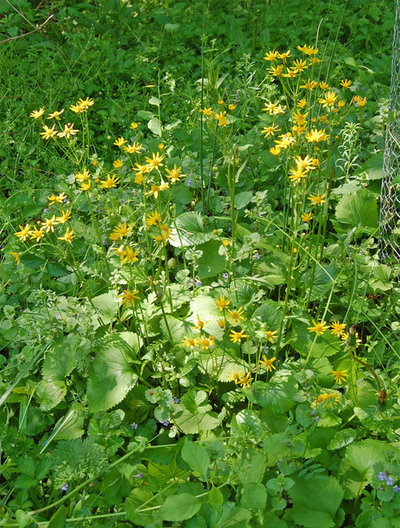 Water requirement:
Water requirement: Prefers moist to wet soils but will grow in average-moisture soils
Light requirement: Open shade to full sunshine but needs more moisture in sunnier sites
Mature size: 6 to 12 inches tall and 6 to 18 inches across; flower stalks are 8 to 24 inches tall
Benefits and tolerances: Flowers attract bees and other beneficial insects; acts as a slope stabilizer; deer- and rabbit-tolerant; tolerates calcium carbonate in soil (calcareous soils) and is good choice for planting near concrete structures; tolerates clay, wet soils and flooding
Seasonal interest: Blooms for three weeks in early to mid-spring followed by fluffy white seed heads in early to mid-summer; evergreen in Zone 6 and warmer
When to plant: Container plants can be put in from spring to early fall. Seeds can be sown directly in the fall; they may also be sown in the spring with germination occurring as the soil warms above 70 degrees Fahrenheit. Cold-stratifying seeds for 45 days results in better rates of germination, especially for seeds started indoors under lights.
Shown: This single golden ragwort plant has spread over two growing seasons to displace some non-native weeds like ground ivy (
Glechoma hederacaea) and purple deadnettle (
Lamium purpureum).
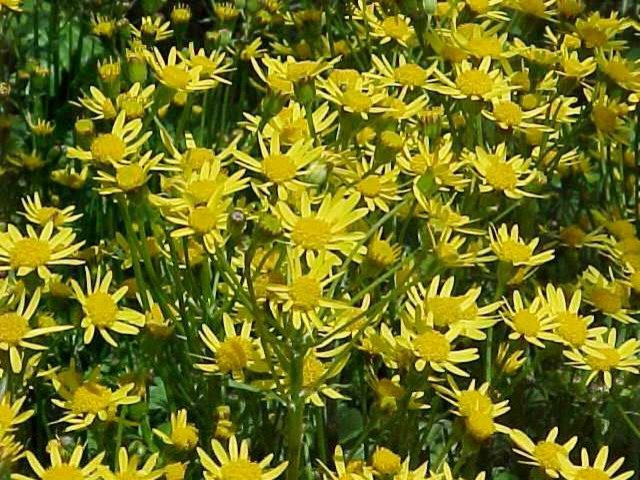
Missouri Botanical Garden
Shown: The daisy-like blooms of golden ragwort will last about three weeks outside, or they can be used indoors as cut flowers.
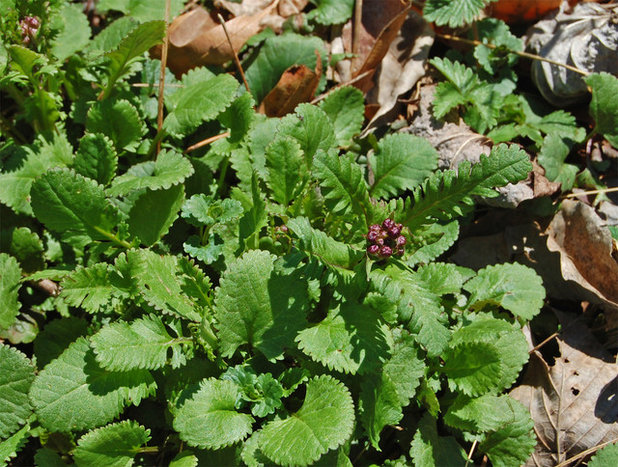 Distinguishing traits.
Distinguishing traits. This early-season wildflower is a good source of pollen and nectar for several species of small native bees as well as beneficial tachinid and syrphid (hover) flies.
In early spring, flower buds with a purple blush form close to ground level, growing up on a flower stalk as the weather warms. The inch-wide golden yellow flowers are held in panicles (clusters) a foot or more above the ground-hugging foliage. Seed ripening takes about two months, at which time the heads open up and release the seeds, each bearing a white tuft. This aids in dispersal of the seeds by the wind. This is the time when golden ragwort is least attractive. To limit spreading, remove spent flowers down to the basal foliage.
Golden ragwort has two types of leaves. The evergreen basal leaves are oval with a deep notch where they join the petiole (stem). The undersides of these leaves often have a purple cast. The leaves on the flower stalk are finely divided. Plants spread out from the central rosette by stolons and rhizomes.
Shown: The purple blush on the flower buds in early April. You can also see both the round basal leaves and the narrower, deeply lobed leaves associated with the flower stalk.
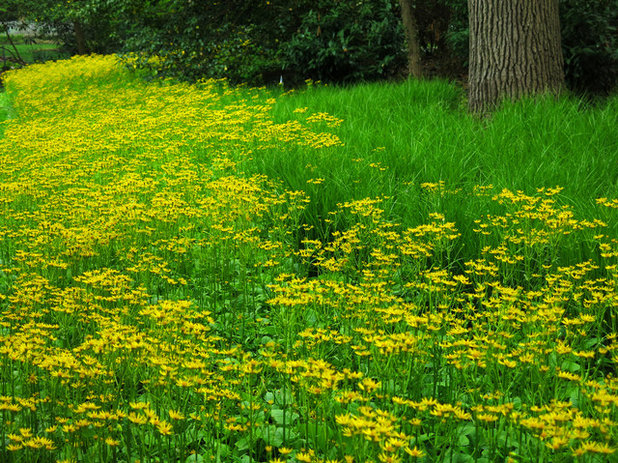
Donald Pell - Gardens
How to use it. Golden ragwort is known for intense flowering in early spring and its persistent, low-growing foliage. As a relatively low-growing plant, it could be used as one component of a lawn alternative. It is a fairly aggressive spreader and will work well in a meadow setting or where you have a large area that needs to be filled in. Its tendency to naturalize makes it a good fit for a cottage garden. Its tolerance for occasional flooding makes it a good choice for a rain garden.
The shallow root system helps stabilize soils prone to erosion and allows it to grow in the midst of established tree roots, making it a good ground cover under trees. Under favorable conditions golden ragwort forms a dense ground cover that competes well against exotic invasive species like garlic mustard (
Alliaria petiolata) and Japanese stiltgrass (
Microstegium vimineum).
Some other natives that bloom alongside golden ragwort are red columbine (
Aquilegia canadensis), Virginia bluebells (
Mertensia virginica), Solomon’s seal (
Polygonatum biflorum), celandine poppy (
Stylophorum diphyllum) and rue anemone (
Thalictrum thalictroides). For a year-round composition, include shade-tolerant plants like white turtlehead (
Chelone glabra), white wood aster (
Eurybia divaricata), cardinal flower (
Lobelia cardinalis), cinnamon fern (
Osmunda cinnamomea) and Christmas fern (
Polystichum acrostichoides).
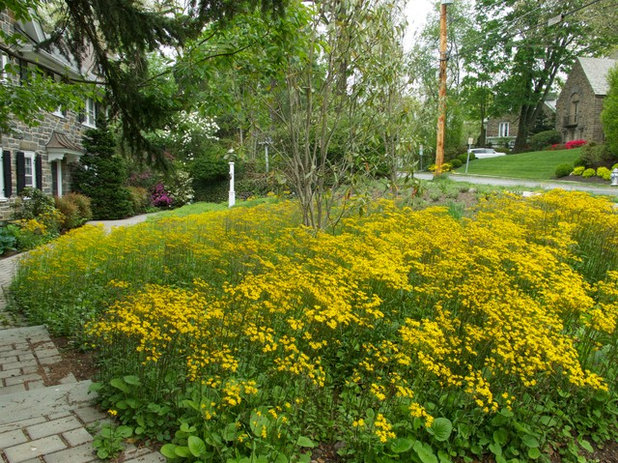
Donald Pell - Gardens
Planting notes. One of the concerns with this plant is its tendency to spread. This is of greater concern in more formal garden settings or where growing conditions are ideal. Spreading by seed can be limited by removing the tall seed stalks before they mature in the summer. Lateral spread can be controlled by cutting back runners, adding physical barriers and creating zones with drier, sunny conditions.
Individual plants of this species are not particularly long-lived. To keep your population growing, allow some new plants to get established by the runners, or take cuttings from the runners. For a more naturalistic approach, allow some of the seeds to mature and be spread by the wind.
While not widely available, both plants and seeds can be purchased from nurseries featuring native species. Since golden ragwort is a vigorous spreader, you need only a couple of plants to start building your own supply.
There are many other species of native
Packera that are adapted to different regions and growing conditions.
Butterweed (
P. glabella) is better-adapted for moist conditions in full to partial sun.
Roundleaf ragwort, or squaw weed (
P. obovata), grows in moist to dry-mesic soils and partial to full sun. Neither of these species has the evergreen foliage of golden ragwort.





